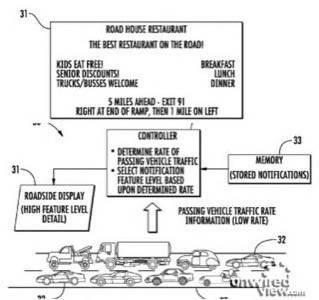RIM, the company behind Blackberry smartphones, is getting into the smart billboard business, according to twopatent applications it filed recently. But what would a smartphone maker and roadside advertising have in common? It could be a new way to serve up “adaptive” advertising according to data gathered from nearby Blackberry users.

According to mobile-focused blog Unwired View, the innovation comes in the form of using nearby phones to measure traffic speed and density and then adapting a billboard’s content accordingly.

When traffic is moving fast and drivers have no time to pay attention to billboards, or there’s a dense crowd on the street so you are distracted and less likely to pay attention, the billboard may just blast a huge logo and slogan of the advertiser at you, to catch any peripheral attention it can get. When traffic slows down in a jam, and you are sitting bored at the wheel waiting for a car in front to move the next few meters, grateful for any distraction, the same billboard will give you a detailed information about the service, prices, benefits and stuff.
The two separate patents are for “Adaptive roadside billboard system and related methods” and “Adaptive pedestrian billboard system and related methods”; both are described as having a storage system that could retain a number of different messages for different speeds and traffic densities. Beyond the level of detail involved, such a system could also be used to offer interaction opportunities when density is high and speed is low (such as in a traffic jam).
The next step, of course, is for billboards to begin collecting more personal information than simply crowd-aggregated data – such as the types of cars being driven – to cater advertising more specifically to the people present. That same next step, however, treads on thinner ice in regards to privacy than simply the density and speed of traffic, which is already used by systems such as Google Maps to provide traffic analysis.









